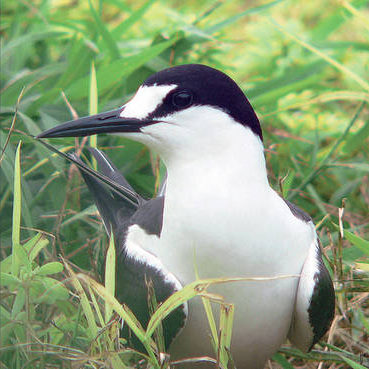Published in the Ocean Watch column, Honolulu Star-Advertiser © Susan Scott
July 7, 2018
Reader Mark Hamamoto emailed that while kayaking off Makua beach, he saw a spiderlike creature skimming over the surface of the water about 200 yards from shore. “Any idea what this is?” Mark wrote. “Never seen this before.”
I did know what it was, because there’s only one marine insect in the world and it walks on water. It’s called a sea strider or sea skater, with the scientific name Halobates.
Each time I read up on these creatures, I discover something amazing about them. A few years back I learned that seabirds called Bonin petrels search out and eat these quarter-inch-long offshore insects. This time I learned that sea striders are attaching their eggs to plastic debris.
 A bit larger than our white terns, sooty terns nest in
A bit larger than our white terns, sooty terns nest in
large numberson Moku Manu and Manana islands off Oahu,
on islands in the Northwest chain and throughout the warm oceans of the world.
©2018 Susan Scott
In the past sea striders only had naturally floating substances such as pumice, seaweed and driftwood on which to glue their eggs. Those items are fairly rare in the open ocean. Today, though, plastic is plentiful.
More eggs produce more sea striders, and that means more food for the animals that eat them. The downside, though, is that sea striders eat, too. A significant increase in their populations could deplete the plankton they feed on.
Like Portuguese men of war and other surface animals, we see sea skaters in Hawaii’s bays during prolonged onshore winds, such as we’ve had lately.
Another reader, Ruth Ann Cullen, emailed that she enjoyed my columns from Alaska about Pacific golden plovers. She knew about the Hawaii-Alaska connection, but “I just returned from an African safari … and was amazed to find plovers there, too. Who knew?”
I didn’t. Do Pacific golden plovers, I wondered, go to Africa, too?
No, but a close relative does. It’s called the black- bellied plover by people in the Pacific and the Americas, and the gray plover by people in Europe, Africa and Asia.
The black-bellied plover is one of the most wide- ranging shorebirds in the world, raising its young in Alaska and Siberia, and then flying just about everywhere in the world, including South Africa, for the winter.
This plover is as breathtakingly beautiful as our kolea. We saw several black-bellied plovers on the tundra during my recent Nome trip, and although the breeding colors are similar, the all-black belly and white head made it easy to tell the difference.
Longtime reader Beverly Kai wrote that she watched three terns swooping around Queen Street in Kakaako. When they landed on a streetlamp, she saw, from her 18th-floor apartment, that they had black heads.
Beverly wondered whether these might be the Arctic terns I wrote about recently, but I think not. Since that tern species is extremely rare in Hawaii, and the black-headed sooty terns are quite common, I would guess they were “sooties.”
To all the long-distance travelers we see here in Hawaii, I join Beverly in wishing them bon voyage.